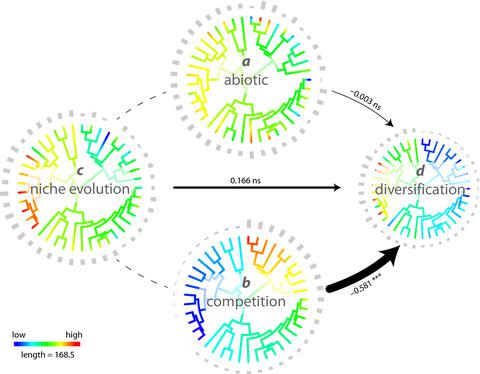当前位置:
X-MOL 学术
›
Ecol. Evol.
›
论文详情
Our official English website, www.x-mol.net, welcomes your
feedback! (Note: you will need to create a separate account there.)
Diversification in evolutionary arenas-Assessment and synthesis.
Ecology and Evolution ( IF 2.3 ) Pub Date : 2020-05-19 , DOI: 10.1002/ece3.6313 Nicolai M Nürk 1 , H Peter Linder 2 , Renske E Onstein 3 , Matthew J Larcombe 4 , Colin E Hughes 2 , Laura Piñeiro Fernández 2, 5 , Philipp M Schlüter 5 , Luis Valente 6, 7 , Carl Beierkuhnlein 8 , Vanessa Cutts 9 , Michael J Donoghue 10 , Erika J Edwards 10 , Richard Field 9 , Suzette G A Flantua 11 , Steven I Higgins 12 , Anke Jentsch 13 , Sigrid Liede-Schumann 1 , Michael D Pirie 14, 15
Ecology and Evolution ( IF 2.3 ) Pub Date : 2020-05-19 , DOI: 10.1002/ece3.6313 Nicolai M Nürk 1 , H Peter Linder 2 , Renske E Onstein 3 , Matthew J Larcombe 4 , Colin E Hughes 2 , Laura Piñeiro Fernández 2, 5 , Philipp M Schlüter 5 , Luis Valente 6, 7 , Carl Beierkuhnlein 8 , Vanessa Cutts 9 , Michael J Donoghue 10 , Erika J Edwards 10 , Richard Field 9 , Suzette G A Flantua 11 , Steven I Higgins 12 , Anke Jentsch 13 , Sigrid Liede-Schumann 1 , Michael D Pirie 14, 15
Affiliation

|
Understanding how and why rates of evolutionary diversification vary is a key issue in evolutionary biology, ecology, and biogeography. Evolutionary rates are the net result of interacting processes summarized under concepts such as adaptive radiation and evolutionary stasis. Here, we review the central concepts in the evolutionary diversification literature and synthesize these into a simple, general framework for studying rates of diversification and quantifying their underlying dynamics, which can be applied across clades and regions, and across spatial and temporal scales. Our framework describes the diversification rate (d ) as a function of the abiotic environment (a ), the biotic environment (b ), and clade‐specific phenotypes or traits (c ); thus, d ~ a,b,c . We refer to the four components (a –d ) and their interactions collectively as the “Evolutionary Arena.” We outline analytical approaches to this framework and present a case study on conifers, for which we parameterize the general model. We also discuss three conceptual examples: the Lupinus radiation in the Andes in the context of emerging ecological opportunity and fluctuating connectivity due to climatic oscillations; oceanic island radiations in the context of island formation and erosion; and biotically driven radiations of the Mediterranean orchid genus Ophrys . The results of the conifer case study are consistent with the long‐standing scenario that low competition and high rates of niche evolution promote diversification. The conceptual examples illustrate how using the synthetic Evolutionary Arena framework helps to identify and structure future directions for research on evolutionary radiations. In this way, the Evolutionary Arena framework promotes a more general understanding of variation in evolutionary rates by making quantitative results comparable between case studies, thereby allowing new syntheses of evolutionary and ecological processes to emerge.
中文翻译:

进化领域的多样化——评估和综合。
了解进化多样化速率如何以及为何变化是进化生物学、生态学和生物地理学的一个关键问题。进化速率是根据适应性辐射和进化停滞等概念总结的相互作用过程的最终结果。在这里,我们回顾了进化多样化文献中的核心概念,并将它们综合成一个简单、通用的框架,用于研究多样化率并量化其潜在动态,该框架可以跨分支和区域、跨空间和时间尺度应用。我们的框架将多样化率( d )描述为非生物环境( a )、生物环境( b )和进化枝特异性表型或性状( c )的函数;因此, d ~ a,b,c 。我们将四个组件( a – d )及其相互作用统称为“进化竞技场”。我们概述了该框架的分析方法,并提出了针叶树的案例研究,为此我们对一般模型进行了参数化。我们还讨论了三个概念性例子:在新兴生态机遇和气候波动导致的连通性波动的背景下,安第斯山脉的羽扇豆辐射;岛屿形成和侵蚀背景下的海洋岛屿辐射;以及地中海兰花属Ophrys的生物驱动辐射。针叶树案例研究的结果与长期存在的观点一致,即低竞争和高生态位进化率促进多样化。 这些概念性示例说明了使用综合进化竞技场框架如何帮助确定和构建进化辐射研究的未来方向。通过这种方式,进化竞技场框架通过使案例研究之间的定量结果具有可比性,促进了对进化速率变化的更普遍的理解,从而使进化和生态过程的新综合得以出现。
更新日期:2020-06-26
中文翻译:

进化领域的多样化——评估和综合。
了解进化多样化速率如何以及为何变化是进化生物学、生态学和生物地理学的一个关键问题。进化速率是根据适应性辐射和进化停滞等概念总结的相互作用过程的最终结果。在这里,我们回顾了进化多样化文献中的核心概念,并将它们综合成一个简单、通用的框架,用于研究多样化率并量化其潜在动态,该框架可以跨分支和区域、跨空间和时间尺度应用。我们的框架将多样化率( d )描述为非生物环境( a )、生物环境( b )和进化枝特异性表型或性状( c )的函数;因此, d ~ a,b,c 。我们将四个组件( a – d )及其相互作用统称为“进化竞技场”。我们概述了该框架的分析方法,并提出了针叶树的案例研究,为此我们对一般模型进行了参数化。我们还讨论了三个概念性例子:在新兴生态机遇和气候波动导致的连通性波动的背景下,安第斯山脉的羽扇豆辐射;岛屿形成和侵蚀背景下的海洋岛屿辐射;以及地中海兰花属Ophrys的生物驱动辐射。针叶树案例研究的结果与长期存在的观点一致,即低竞争和高生态位进化率促进多样化。 这些概念性示例说明了使用综合进化竞技场框架如何帮助确定和构建进化辐射研究的未来方向。通过这种方式,进化竞技场框架通过使案例研究之间的定量结果具有可比性,促进了对进化速率变化的更普遍的理解,从而使进化和生态过程的新综合得以出现。











































 京公网安备 11010802027423号
京公网安备 11010802027423号